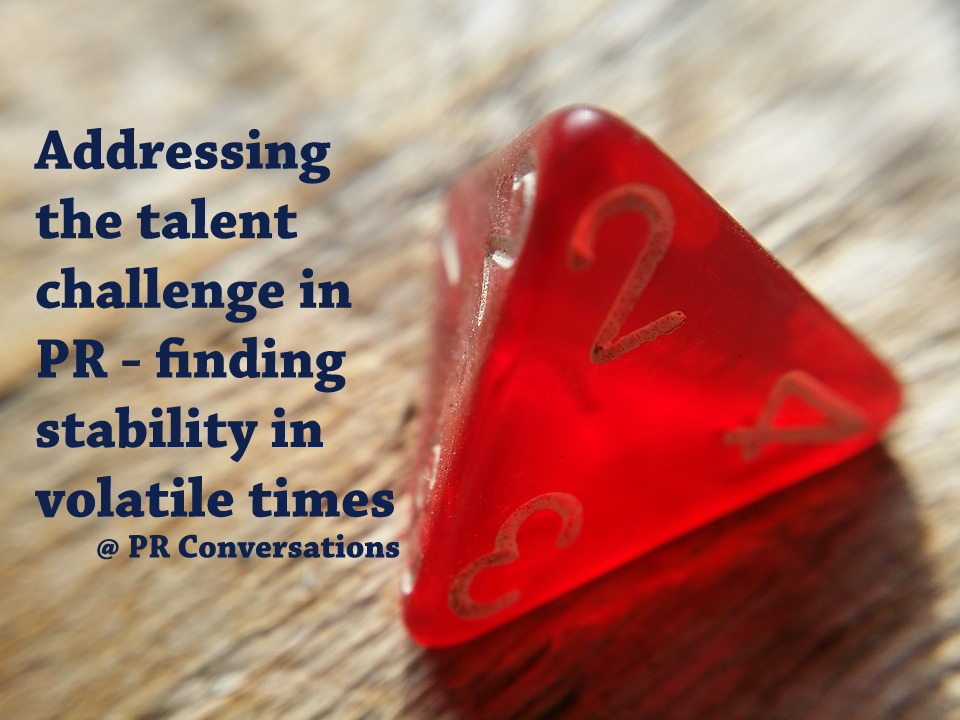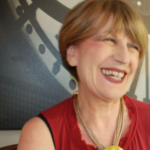
There is no shortage of opinion on the future of work. One thing that most people agree is that “the way individuals look for work and companies identify and recruit talent” is changing. This largely means matching services using digital platforms. Another trend is towards flexible working within a ‘gig economy’.
In this PR Conversation post, I discuss how these developments affect the PR industry, with Nigel Sarbutts, founder of The PR Cavalry, a service designed to connect public relations freelancers with clients and PR agencies based on data and logic.

Nigel Sarbutts
The traditional PR agency and in-house team structure needs to adapt quite rapidly to the volatility that seems to be the new normal.
This volatility takes two forms:
- Time volatility. Projects being on one month and delayed the next seems to be a more common complaint than it ever was, perhaps a reflection of the political and economic volatility that we see every day. In the UK, Brexit, whatever your take on it, has introduced an enormous amount of mid to long term uncertainty for many organisations.
- Scope volatility. It is normal now for even routine meetings on a PR project to cover types of outputs which would have been rarities five years ago – SEO, paid search, native advertising, content marketing (including video, data, graphics) are examples of work that most PR practitioners need to incorporate into their expertise, along with the ongoing need to be expert at the traditional outputs of media relations.
For anyone responsible for structuring their agency or team, these pressures lead to difficult questions about resources.
If my income forecast is more volatile, with projects moving between quarters unpredictably and even falling from H2 into next year, how can I square that with a team structure that is far less adaptable?
If the PR outputs demanded by clients/stakeholders are more broad, how can we maintain high levels of expertise in both traditional PR skillsets and a range of ‘new’ outputs that might not occupy a person full-time?
What is core and what is not when looking at the mix of experience we need to invest in?
The traditional pyramid model of an agency or in-house team is a legacy of PR as a craft where experience saw you climb the ranks in the reasonable expectation that the nature of what you do is incrementally more strategic and that you would pick up people management skills along the way. Volatility places more emphasis on technical/task knowledge and delivery of results to shorter timespans and is the enemy of incremental change.

Dr Heather Yaxley
Undoubtedly there are numerous pressures affecting public relations currently, but one of the greatest challenges is availability of the right talent to deploy at the right time. The volatility in time frames and nature of work under the remit of PR, demands flexibility and new solutions.
There has started to be some discussion around the use of technology (most recently AI) and agile planning methods as ways to adapt to the changing work environment. But there’s been less focus on the implications for PR practitioners – including how these proposed ’solutions’ bring with them additional people related issues.
We also have to add into the discussion the volatile nature of careers in public relations. This is most evident within consultancies – but also applies in-house, given that most practitioners are faced with changing employers to craft their careers.
Looking further into the impact of volatility, we need to recognise the consequences not only for employers, but for individuals. Whilst the number of people employed in public relations has increased exponentially in recent decades, this growth hides evidence that public relations careers are unstable. There are many causes for this employment instability. For example, it is common for PR practitioners to be vulnerable to department restructures, agency takeovers, senior management beliefs about the function and so forth.

Nigel Sarbutts
In respect of the AI discussion, I hope that it avoids the temptation to focus on the output end of PR (the automation of content creation or audience targeting and the application of AI to evaluate media coverage or sentiment).
There is much to consider at the other end – the inputs to the industry of which the biggest will always be talent. Whilst what The PR Cavalry is doing is not AI, it is algorithm based and makes the talent acquisition process more logical and codified.
If we breakdown the traditional pyramid, it’s in the middle is where all the problems lie. A team of 25 might have:
- At the top, three directors – the trusted advisors who are essential. They will be mainly focused on business management, new business and some touches on the tiller with clients (be they external or internal).
- At the bottom are 14 or so people with under 7 to 8 years experience who are the ultra-tacticians. They are busy but don’t really know why they are doing what they do each day.
In the middle, there will be six people who are key to a project being a success or failure.
If your staff turnover is at the typical 25% rate (ie people stay for c. 4 years), of your 6 mid-tiers, 1 or 2 are leaving within the next few months and 1 or 2 have been with you the same amount of time.
Out of 25 people you have only 1 or 2 who are stable in their employment with you. They are the ones in positions that change the day to day performance of the business or team. In an agency setting they are become the A-team who get put forward for every pitch.
Given the squeeze on the mid rank – where so much depends on the performance of a few – instability isn’t a great surprise.
It may manifest itself as people asserting their worth and demanding rapid advance (typically to managerial positions of status which require completely new skillsets and personality traits) or it may lead to people deciding they don’t need that kind of pressure and they are better off going solo where they can focus on what they enjoy – executing work – rather than the ‘stuff’ that goes on in the corporate setting.
The squeezed middle results in a lot of critical client knowledge leaving the agency and needing to be recreated every year – at the agency’s cost.
Perhaps if training and development programmes were better resourced, the investment would be a lot smaller than the cost of reinventing knowledge each year!

Dr Heather Yaxley
Historical analysis I have undertaken in relation to PR careers within the UK reveals concerns about employment volatility dating back to the 1970s and 1980s. For instance, a 1987 PR Week survey reported clients complaints concerning “the frequency of personnel changes within the consultancy team dealing with their business”.
A report by Hollis International published in 1976 stated:
“The rate of transfers, promotions, and other employment changes in the public relations field is extraordinarily high”
My work reveals that the notion of hierarchical career development within a single or few employers is not only dated, but never reflected the career experiences of the majority of people.
By design, the pyramid or ladder concept focuses on the few people whose careers reflect the Mad Men model. It tends to ignore – or worse, to denigrate – those who don’t pursue hierarchical career development.
I agree that we need much more focus on mid-career development – your “squeezed middle”. And yes, better training and development is vital in attracting smart people to build sustainable careers in public relations as I recently discussed with Ann Pilkington founder of PR Academy, the largest provider of professional PR qualifications in the UK.
My research also shows that the idea of a binary career choice of working either in-house or in consultancies is simplistic. The industry offers three main employment options, yet little attention is paid to self-employment or independent practice. Within the industry’s tripartite structure, I found that it was common for careers in public relations to weave together experience gained in each form of employment.
Calculating a demography for public relations is incredibly unreliable, but data for 2004/2005 suggested two percent of PR practitioners in the UK work in small consultancies or self-employed. CIPR’s State of the Profession surveys in recent years have indicated that one in eight people working in the occupation are independent practitioners.
In the future, a greater percentage of practitioners will undertake freelance work – or other flexible types of employment – during their careers.
In turn, of course, this means a significant amount of PR work is being outsourced or managed outside of agency and in-house structures. For me this suggests that there is an enormous resource that is under-recognised, under-studied – and importantly, under-valued, as an asset within public relations. Would you agree?

Nigel Sarbutts
Yes, if we use the PRCA figure of 86,000 PR practitioners in the UK and the CIPR finding that 16% work as independent practitioners, we have 14,000 people about which little is known beyond their incomes (average £63k from the CIPR survey). A sector valued at an estimated £882m is worth examining more closely.
Every agency director knows that feeling when a pitch comes in – who to put on the team? You want your A-team, but they are already maxed out precisely because they are good. It can be very tempting to win the business and worry about servicing it later – especially in holding company agencies where the pressure to hit that quarter’s numbers is intense (to the point of career threatening) and often takes precedence over examining uncomfortable truths about why a client was lost 18 months later as a result of client frustrations.
Given the forms of volatility we spoke about earlier, the answer is to make better use of independent practitioners. The problem is that it’s time consuming and haphazard for agencies and in-house clients to find freelancers with the ideal mix of industry knowledge plus experience of the kind of work needed plus recent contacts. It’s just as laborious for freelancers to find precise briefs truly matched to their skillset.
Increasingly public relations is about flexible, expert teams who just get stuff done.
We make that easier to happen. We find PR agencies and in-house departments are understandably pretty clear in how they evaluate talent – but struggle with finding good people. With the more occasional buyers of PR services (digital agencies and some SMEs without dedicated marketing resource), they struggle to distinguish between different PR practitioners.
There is definitely a need for more research of independent practice within public relations. At The PR Cavalry, we aim to contribute to improving understanding and in so doing move freelancing further into the category of strategic resource.
- Nigel Sarbutts via LinkedIn or Twitter: @NigelSarbutts
- Dr. Heather Yaxley via LinkedIn or Twitter: @Greenbanana.

Worth reading